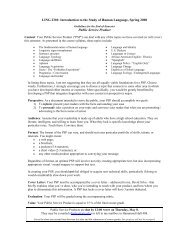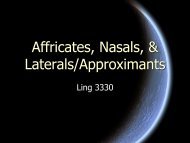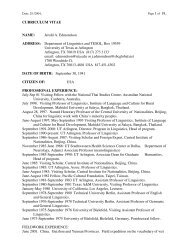1 A phonetic study of the Sui consonants and tones Jerold A ...
1 A phonetic study of the Sui consonants and tones Jerold A ...
1 A phonetic study of the Sui consonants and tones Jerold A ...
You also want an ePaper? Increase the reach of your titles
YUMPU automatically turns print PDFs into web optimized ePapers that Google loves.
<strong>and</strong> Abramson, A. S. (1999).<br />
In 1943, Li Fang Kuei described two different kinds <strong>of</strong> preglottalized voiced stops in Tai<br />
languages (Li 1943: 178-179). The first type <strong>of</strong> preglottalized stop Li called a strongly<br />
preglottalized voiced stop. In this sound <strong>the</strong> initial glottal stop is clearly perceptible <strong>and</strong> <strong>the</strong><br />
voiced stop following <strong>the</strong> glottal stop is fully voiced. In our analysis <strong>of</strong> <strong>Sui</strong>, our native speaker<br />
produced strong preglottalized stops like Li's type one. Although in <strong>the</strong> literature on <strong>the</strong> <strong>Sui</strong><br />
language, <strong>the</strong> preglottalized stops have sometimes been reported to be slightly imploded in <strong>the</strong>ir<br />
onset. Our airflow studies show that <strong>the</strong> <strong>Sui</strong> preglottalized stops are normally not true implosives<br />
but are very much as Li first described <strong>the</strong>m (Li 1943: 178-9). They are preceded by a moderate<br />
glottal stop, <strong>and</strong> <strong>the</strong> voiced consonant following this initial glottal stop is in modal voice.<br />
Anthony Traill (personal communication) reports that <strong>the</strong> initial preglottalized nasals [�m] <strong>and</strong><br />
[�n] in !�o��o Bushman are preceded by a moderate glottal stop <strong>and</strong> <strong>the</strong> nasal <strong>and</strong> following<br />
vowel are not colored by any type <strong>of</strong> creaky phonation. In o<strong>the</strong>r words <strong>the</strong>y are very much like<br />
Li's (1943) type one preglottalized stops.<br />
The initial voiceless unaspirated oral stops <strong>and</strong> affricates <strong>of</strong> <strong>Sui</strong> [p t ts t� k q] are all<br />
made with a PREPHONATION state <strong>of</strong> <strong>the</strong> glottis (Harris 1999: 2042-3; 2001:4-5), cf. Figure 1. In<br />
<strong>the</strong> production <strong>of</strong> <strong>the</strong> prephonation state <strong>of</strong> <strong>the</strong> glottis, <strong>the</strong> ventricular folds are abducted <strong>and</strong> <strong>the</strong><br />
arytenoid cartilages are adducted as for modal voice, but <strong>the</strong> true vocal folds are not completely<br />
closed. The vocal folds form a narrowed convex-convex opening medially in <strong>the</strong> glottis <strong>and</strong><br />
<strong>the</strong>re is insufficient subglottal air pressure during <strong>the</strong> closure phase <strong>of</strong> <strong>the</strong> articulatory stricture to<br />
initiate an airflow through <strong>the</strong> narrowed glottal opening. A very small airflow through <strong>the</strong> glottis<br />
is initiated during <strong>the</strong> release phase <strong>of</strong> <strong>the</strong> consonant <strong>and</strong> <strong>the</strong> overlapping onset phase <strong>of</strong> <strong>the</strong><br />
following vowel when <strong>the</strong> subglottal air pressure increases <strong>and</strong> a small amount <strong>of</strong> air escapes<br />
through <strong>the</strong> narrowed glottis. This small amount <strong>of</strong> air is used to help initiate <strong>the</strong> first stage <strong>of</strong><br />
<strong>the</strong> glottal cycles <strong>of</strong> voice <strong>and</strong> produces a predictable small amount <strong>of</strong> Voice Onset Time (VOT)<br />
lag before <strong>the</strong> full voicing cycles <strong>of</strong> <strong>the</strong> following vowel are reached.<br />
The syllable initial voiceless aspirated oral stops <strong>and</strong> affricates [ph th tsh t�h kh qh],<br />
<strong>the</strong> voiceless fricatives [f s � x h], <strong>and</strong> <strong>the</strong> voiceless nasals [m� n� �� ��] are all made with a BREATH<br />
(VOICELESSNESS) state <strong>of</strong> <strong>the</strong> glottis, cf. Figure 2. 3 In <strong>the</strong> brea<strong>the</strong>d /br��t/ state <strong>of</strong> <strong>the</strong> glottis <strong>the</strong><br />
[m�m].<br />
3 In all photographs <strong>the</strong> top <strong>of</strong> <strong>the</strong> picture corresponds to <strong>the</strong> back or posterior part <strong>of</strong> <strong>the</strong> larynx.<br />
Voiceless nasals in <strong>Sui</strong> begin with a breath state <strong>of</strong> <strong>the</strong> glottis <strong>and</strong> end with a voiced state <strong>of</strong> <strong>the</strong> glottis<br />
5





